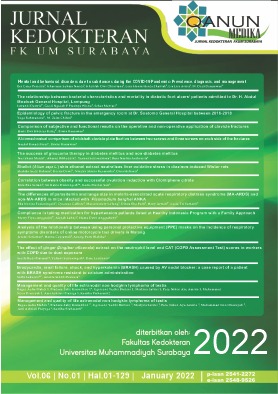Epidemiology of pelvic fracture in the emergency room at Dr. Soetomo General Hospital between 2016-2018
Abstract
ABSTRACT
Â
Pelvic fracture is a rare case. The incidence is about 3% to 8% of the whole kind of fractures. The most common cause is high energy trauma and is associated with multi-trauma. The amount of pelvic trauma patients is 63,000 and is associated with increased mortality rates. The scientific data is needed because it is helpful for trauma prevention and management. This research is a descriptive observational study that examines the epidemiology of pelvic trauma. The population was patients with pelvic trauma who came to the ER RSUD Dr. Soetomo in 2016-2018. The total sample was 229 patients. A total of 149 patients (65.1%) were male, and 80 patients (34.9%) were female. Traffic accidents caused 173 patients (76%) cases. Tile A classification was most frequent in 117 patients (51.1%). There were 178 patients (77.7%) who were multi-trauma patients. The most common treatment was pelvic bandage with 95 patients (41.5%). There were 178 multi-trauma patients, 109 patients (61.2%) who underwent emergency surgery for trauma, and 69 patients (38.8%) who did not. The most common cause of pelvic fracture in Dr. Soetomo general hospital during 2016-2018 was trauma with high energy due to traffic accidents. The most common type of pelvic fracture was Tile A. The more severe the pelvic trauma, the treatment should be more aggressive.
Full text article
References
Andrich, S. et al. (2015) ‘Epidemiology of pelvic fractures in Germany: considerably high incidence rates among older people’, PLoS One, 10(9), p. e0139078.
Breuil, V., Roux, C. H. and Carle, G. F. (2016) ‘Pelvic fractures: epidemiology, consequences, and medical management’, Current opinion in rheumatology, 28(4), pp. 442–447.
Eluwa, M. A. et al. (2010) ‘Disposition of fractures and dislocations among road accident victims in rivers and bayelsa states of Nigeria from 1992–2005’, IJE, 8(1).
Ghosh, S. et al. (2019) ‘Epidemiology of pelvic fractures in adults: Our experience at a tertiary hospital’, Chinese journal of traumatology, 22(3), pp. 138–141.
Magnone, S. et al. (2014) ‘Management of hemodynamically unstable pelvic trauma : results of the first Italian consensus conference ( cooperative guidelines of the Italian Society of Surgery , the Italian Association of Hospital Surgeons , the Multi-specialist Italian Society of Young Surgeons , the Italian Society of Emergency Surgery and Trauma , the Italian Society of Anesthesia , Analgesia , Resuscitation and Intensive Care , the Italian Society of Orthopaedics and Traumatology , the Italian Society of Emergency Medicine , the Italian Society of Medical Radiology -Section of Vascular and Interventional Radiology- and the World Society of Emergency Surgery )’, pp. 1–8.
Organization, W. H. (2015) Global status report on road safety 2015. World Health Organization.
Pereira, G. J. C. et al. (2017) ‘Epidemiology of pelvic ring fractures and injuries’, Revista Brasileira de Ortopedia, 52(3), pp. 260–269.
Sathy, A. K. et al. (2009) ‘The effect of pelvic fracture on mortality after trauma: an analysis of 63,000 trauma patients’, JBJS, 91(12), pp. 2803–2810.
Schulman, J. E. et al. (2010) ‘Pelvic ring fractures are an independent risk factor for death after blunt trauma’, Journal of Trauma and Acute Care Surgery, 68(4), pp. 930–934.
Tosounidis, T. H. et al. (2015) ‘The use of buttress plates in the management of acetabular fractures with quadrilateral plate involvement: is it still a valid option?’, International orthopaedics, 39(11), pp. 2219–2226.
Verbeek, D. O. et al. (2018) ‘Pelvic fractures in the Netherlands: epidemiology, characteristics and risk factors for in-hospital mortality in the older and younger population’, European Journal of Orthopaedic Surgery & Traumatology, 28(2), pp. 197–205.
Vidyarthi, D. A. and Nayak, D. (2018) ‘Study of incidence and prevalence of pelvic fractures in Central India’, J Med Sci Clin Res.
Weaver, M. J. and Heng, M. (2015) ‘Orthopedic Approach to the Early Management of Pelvic Injuries Orthopedic Approach to the Early Management of Pelvic Injuries’, (March). doi: 10.1007/s40719-014-0005-4.
Wedel, V. L. and Galloway, A. (2013) Broken bones: anthropological analysis of blunt force trauma. Charles C Thomas Publisher.
Yang, N.-P. et al. (2014) ‘Epidemiology of hospitalized traumatic pelvic fractures and their combined injuries in Taiwan: 2000–2011 National Health Insurance data surveillance’, BioMed research international, 2014.
Young, M. S., Birrell, S. A. and Stanton, N. A. (2011) ‘Safe driving in a green world: A review of driver performance benchmarks and technologies to support ‘smart’driving’, Applied ergonomics, 42(4), pp. 533–539.
Authors

Qanun Medika by FK UM Surabaya is liscence under Lisensi Creative Commons Atribusi 4.0 Internasional.

